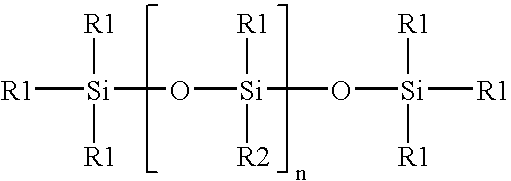Silsesquioxane resin wax
a technology of silicon dioxide and resin wax, applied in the direction of synthetic resin layered products, make-up, coatings, etc., to achieve the effect of enhancing the durability and substantivity of cosmetics
- Summary
- Abstract
- Description
- Claims
- Application Information
AI Technical Summary
Benefits of technology
Problems solved by technology
Method used
Image
Examples
example 1
Reference
Preparation of MMHTPr Resins from TPr Silsesquioxane Resin
[0142] A 3-neck reaction flask equipped with an agitator, temperature probe, Dean Stark trap and condenser was charged with a T propyl resin, hexamethyldisiloxane, tetramethyl-dihydrogendisiloxane and water at the ratios shown in Table 1. The Dean Stark trap was pre-loaded with toluene to insure the solids level was maintained. Trifluoromethanesulfonic acid was added as the catalyst at 0.01 wt % to the reaction mixture in the flask. The temperature of the reaction mixture was maintained at or below 50° C. with a water bath initially as needed. When the temperature stabilized, the temperature was maintained at 50° C. for 3 hours. Then, the reaction mixture was heated at reflux (100-140° C.) and water removed via the Dean Stark trap as needed. After all the water formed in the reaction was removed, the resin mixture was allowed to cool and a 10× molar excess of calcium carbonate (9.31 g to 700 microliters of FC-24) ...
example 2
Reference
Preparation of MMHTPr Resin from Propyl Trimethoxysilane
[0143] A 3-neck reaction flask equipped with an agitator, temperature probe, addition funnel and a condenser was charged with propyl trimethoxysilane, hexamethyldisiloxane, tetramethyldihydrogendisiloxane and FC-24 catalyst at the ratios in Table 1. Water was then added via the addition funnel. The temperature was maintained below 50° C. by regulation of water addition and use of water bath if needed. After the water addition, the temperature was maintained 50° C. for 3 hours. The resulting two phase reaction mixture was then placed in a separatory funnel to separate the aqueous phase from the resin phase. Heptane was added in sufficient amounts to help separate excess water from resin. The collected resin phase was then put back in 3-neck flask and a 10× molar excess CaCO3 was added to neutralize any remaining acid catalyst. Water was also added to remove any methoxy present, and the mixture heated to reflux (100-1...
example 3
TPr Resin Waxes from MMHTPr Resins
[0144] This example describes the procedure used to prepare representative silsesquioxane resin waxes of the present invention. The formulations used and description of the olefinic wax is shown below in Table 3.
[0145] A 3-neck reaction flask equipped with an agitator, temperature probe, and a condenser was charged with a siloxane resin (as prepared via reference example 1 or 2) and sufficient heptane to reduce viscosity. The contents were then heated to 60-70° C. The olefinic wax was then added to the reaction flask and followed by addition of the platinum catalyst. After an initial exotherm, the temperature was maintained at 120° C. for 3-4 hours before checking the Si—H of the wax. The melt points of the resulting waxes were characterized by DSC, and shown in Table 4 below.
PUM
| Property | Measurement | Unit |
|---|---|---|
| melting point | aaaaa | aaaaa |
| weight percent | aaaaa | aaaaa |
| weight percent | aaaaa | aaaaa |
Abstract
Description
Claims
Application Information
 Login to View More
Login to View More - R&D
- Intellectual Property
- Life Sciences
- Materials
- Tech Scout
- Unparalleled Data Quality
- Higher Quality Content
- 60% Fewer Hallucinations
Browse by: Latest US Patents, China's latest patents, Technical Efficacy Thesaurus, Application Domain, Technology Topic, Popular Technical Reports.
© 2025 PatSnap. All rights reserved.Legal|Privacy policy|Modern Slavery Act Transparency Statement|Sitemap|About US| Contact US: help@patsnap.com



